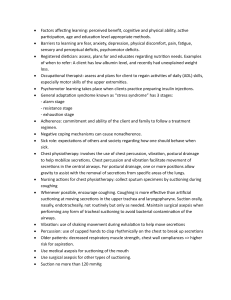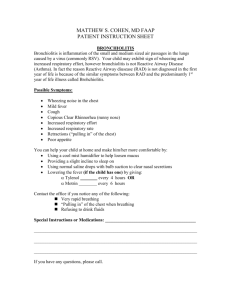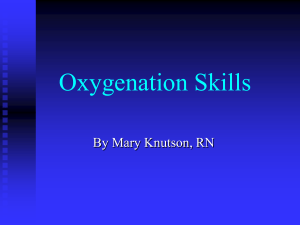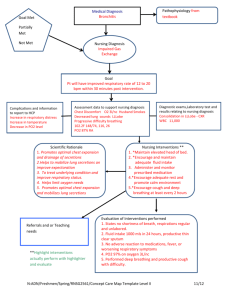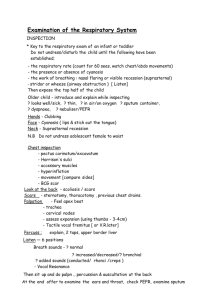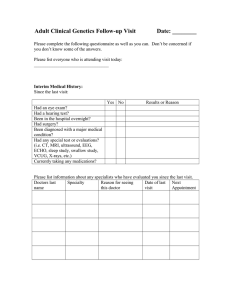ROLE OF PT IN ICU
advertisement
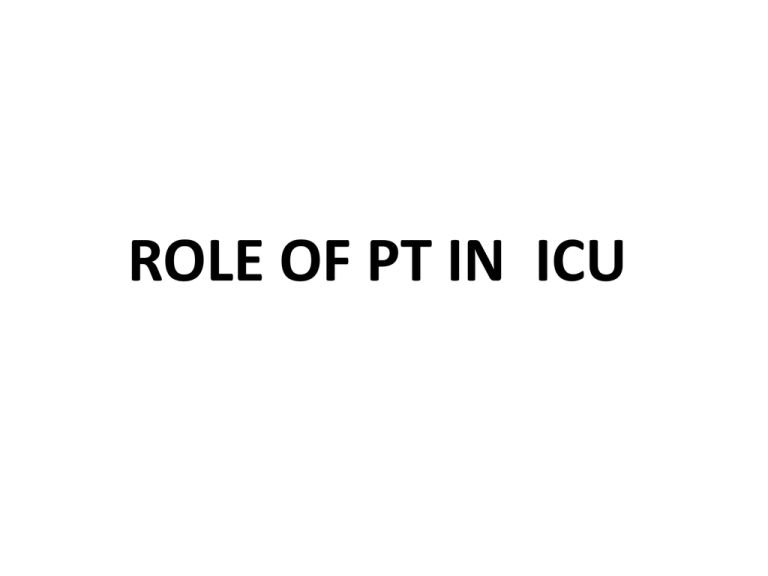
ROLE OF PT IN ICU Goals of PT in ICU 1. Improve / maintain normal or baseline ventilation and oxygenation 2. Improve / maintain musculoskeletal system within functional limit - Improve range of motion - Improve muscle strength and endurance - Prevent joint deformities and contractures Goals-contd... 3. Improve circulatory system function 4. Improve / maintain neurological system and cognitive status within the functional limits. 5. Improve / maintain level of functional status within patient tolerance Assessment • Cardiovascular system • Respiratory system • Neurological system • Renal system • Hematological system • Gastrointestinal system Cardiovascular system • Heart rate and rhythm • Arterial BP • Central Venous pressure • Pulmonary Artery pressure (PAP) Neurological system • Level of consciousness (Glascow coma scale) • Pupils – Size – Reactivity – Equality • Cerebral perfusion pressure (>70mmHg) CPP = MAP- ICP (Mean arterial pressure-Intra cranial pressure) • Intracranial pressure (<10mmHg) Intracranial pressure measurement Renal system • Assessment of fluid balance – Measure of Intravascular volumes – Urine output – Serum electrolytes – ABG Gastrointestinal system • Nutritional support – Routes of administration – Enteral ( Ryles tube) – Parentral ( Venous line) – Oral CARDIO PULMONARY DYSFUNCTION 1. PRIMARY - Respiratory failure - Heart failure - Cardiac surgeries - Thoracic surgeries 2. SECONDARY - Burns - Head injuries - Musculoskeletal trauma - Neuro muscular dysfunctions - Acute spinal cord injuries - Renal failure - Complicated general surgeries Respiratory system • • • • • • • • • • • Auscultation Percussion Expansion Chest X-ray Mode of ventilation Humidification Oxygen therapy Respiratory rate Airway pressures ABG Sputum Assessment General Observation Patient Position Respiration - Airway Endo Tracheal / Tracheostomy Ventillator Mode & FiO2 Vital Signs – Temperature, BP, RR, HR SpO2,GCS, ICP Tubes - CV line, Peripheral line, Chest tubes, Catheters Drugs Examination Auscultations Respiratory pattern Cyanosis Clubbing Radiograph Goals • Prevent accumulation of secretions • Improve mobilization and drainage of secretions • Promote relaxation to improve breathing patterns • Promote improved respiratory function • Improve cardio-pulmonary exercise tolerance Precautions • Untreated tension pneumothorax • Status asthmaticus • Immediately following intra cranial surgery • Head injury with raised ICP • Osteoporotic bones • Recent acute myocardial infarction, unstable vitals • Sutures and Intercostal drainage Physiotherapy Techniques • Gravity-assisted Positioning • Manual techniques • Manual hyperinflation • Airway suctioning • Chest Mobilization Physiological effects of Positioning • Optimizes oxygen transport by improving V/Q mismatch • Increases lung volumes • Reduces the work of breathing • Minimizes the work of heart • Enhances mucociliary clearance (postural drainage) Chest Mobilization • Chest Vibrations • Chest Percussion/Clapping • Postural drainage Chest Percussion / Vibration PERCUSSION consists of rhythmic clapping on the chest with loose wrist & cupped hand. • Effect : Dislodges & loosens secretions from the lung VIBRATIONS consists of a fine oscillation of the hands directed inwards against the chest, performed on exhalation after deep inhalation. • Effects: Helpful in moving loosened mucous plugs towards larger airway Manual Hyperinflation (MH) • This is inflating the lungs with oxygen and manual compression to a tidal volume. Indications • To aid removal of secretions • To aid reinflation of atelectatic segments • To assess lung compliance • To improve lung compliance Hazards of Manual Hyperinflation • • • • • • • Reduction in blood pressure Reduced saturation Raised intracranial pressure Reduced respiratory drive Hemodynamic and metabolic upset Risk of barotrauma Discomfort and anxiety Contraindications • Undrained Pneumothorax • Severe bronchospasm • Cardiac arrhythmias • Unexplained Hemoptysis • Patient on High PEEP (Positive end expiratory pressure) Advantages of MH • Reverses atelectasis • Improves oxygen saturation and lung compliance • Improves sputum clearance Suctioning • Suctioning is the mechanical aspiration of pulmonary secretions from a patient with an artificial airway in place. • Indications – Inability to cough effectively – Sputum plugging – To assess tube patency Contraindication • Frank hemoptysis • Severe brochospasm • Undrained pneumothorax • The suction catheter used must be less than half the diameter of endotracheal tube. • The vacuum pressure should be as low as possible. (60-150mmHg) • Suction should never be routine, only when there is an indication Hazards of suctioning • Mucosal trauma • Cardiac arrhythmias • Hypoxia • Raised intracranial pressure ROUTE OF SUCTION • Nasal and oral suction • Endotracheal suction • Tracheostomy suction Mobilisation • Critically ill (Frequent Position changes, Kinetic & Kinematic Therapy) • Stable (Progressive tilting & Ambulation) Mobilization • ICU rehabilitation has been shown to accelerate recovery • Early mobilization for unconscious patients starts right from turning the patient every two hours. • Graded exercises can be started as soon as the patient regains consciousness. • Activity is required to maintain sensory input, comfort, joint mobility and healing ability. • Activity minimizes the weakness caused by loss of muscle mass • Graded ambulation can be started depending on patients condition

